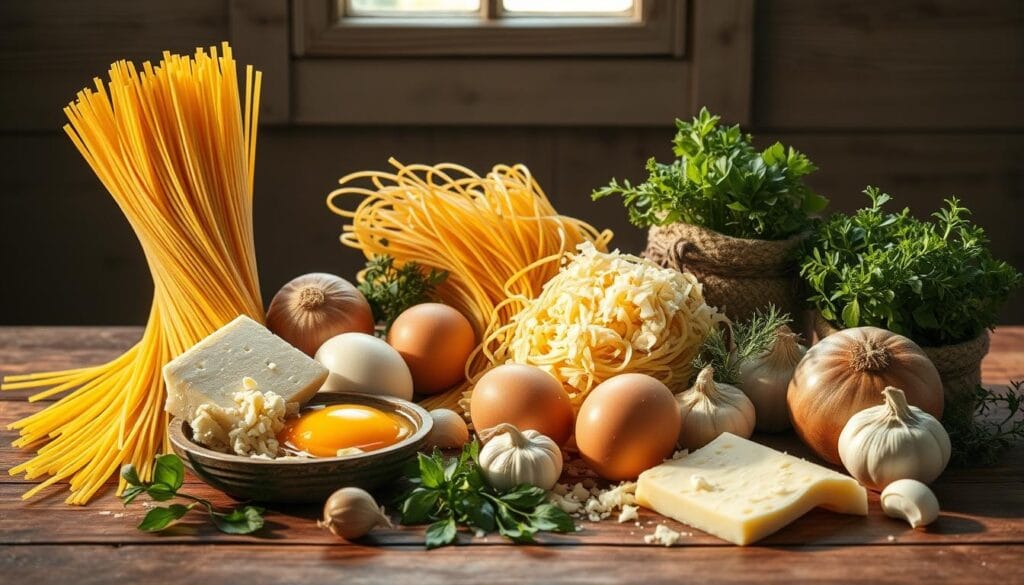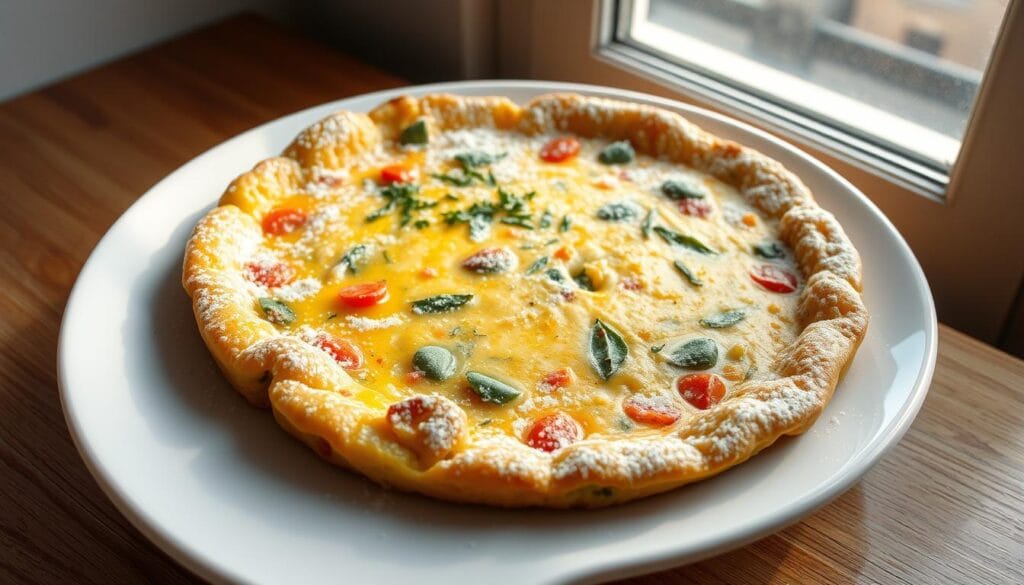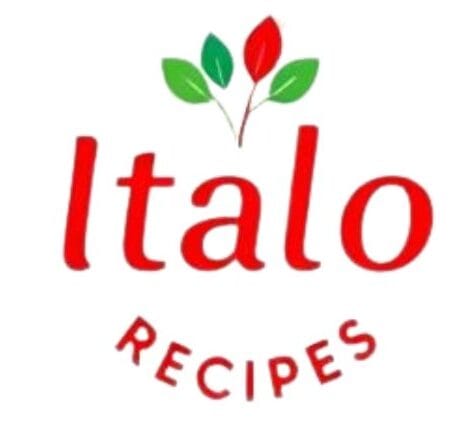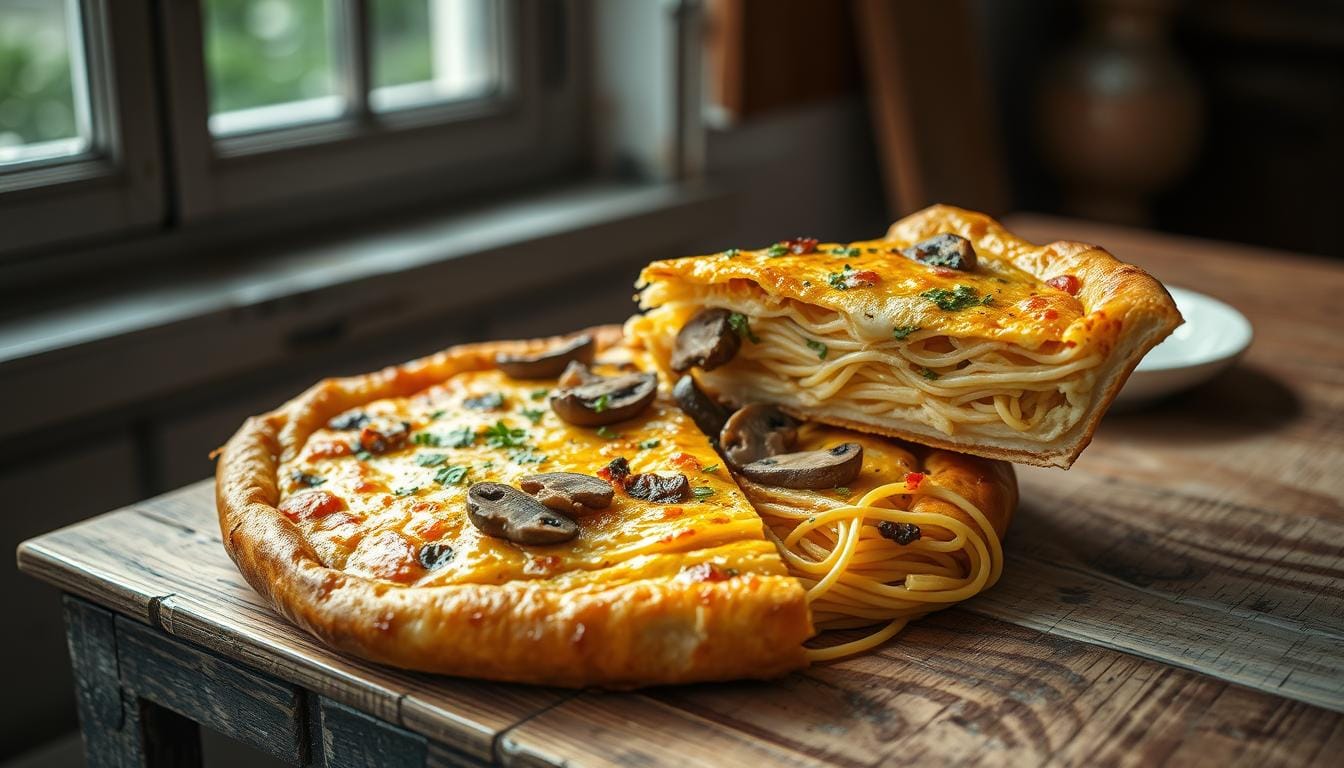Zero Waste in 2025? Maximum Flavor: The Rustic Spaghetti Frittata
Spaghetti frittata:Imagine turning last night’s spaghetti into a tasty breakfast or brunch. This is what Cucina Povera, or « poor cooking, » is all about. It’s about making delicious meals from what you have, cutting down on waste, and boosting flavor.
Try making a rustic spaghetti frittata with leftover pasta. It’s a dish that’s both tasty and good for the planet. By doing this, you’re helping to live a zero waste life.
Table of Contents
Key Takeaways
- Understand the concept of Cucina Povera and its significance in reducing kitchen waste.
- Learn how to creatively repurpose leftover spaghetti into a delicious frittata.
- Discover the benefits of adopting a zero-waste approach in your cooking routine.
- Explore the simplicity and flavor of a rustic spaghetti frittata.
- Embrace sustainable cooking practices that are both nourishing and environmentally friendly.
What is Frettata di Spaghetti Povera?
Frittata di spaghetti lets you taste the heart of Italian cooking. It’s a classic dish that shows the beauty of « Cucina Povera. » This style of cooking is all about using simple ingredients in creative ways.
A Brief History of Frittata
Frittata, or Italian omelette, has been loved for centuries. It started as a simple dish with eggs, veggies, and sometimes pasta or meat. Its flexibility has made it a favorite across Italy, with each region adding its own twist.
The story of frittata is deeply rooted in Italian cooking traditions. It was made with what was available, reducing waste and showing off Italian cooks’ creativity.
The Concept of « Povera » Cuisine
« Cucina Povera » is a big part of Italian cooking. It’s about making tasty meals with simple, local ingredients and leftovers. This approach is all about using what you have and making the most of it.
This way of cooking is not just about saving money. It’s about celebrating the taste and texture of each ingredient. For frittata di spaghetti, it means turning leftover spaghetti into a tasty dish.
An Overview of Italian Cooking Traditions
Italian cooking is all about family, simplicity, and local ingredients. Meals are a chance to come together and share stories. The traditional Italian frittata recipe is a great example, using common ingredients found in most Italian kitchens.
| Key Elements | Description | Relevance to Frittata |
|---|---|---|
| Simple Ingredients | Use of locally sourced, fresh ingredients. | Eggs, spaghetti, and vegetables are staples. |
| Resourcefulness | Utilizing leftovers to minimize waste. | Leftover spaghetti is a common use in frittata. |
| Family and Sharing | Meals are a time for family and friends to gather. | Frittata is often served in a communal setting. |
By following Italian cooking traditions and « Cucina Povera, » you can make delicious meals like frittata di spaghetti. It’s a way to honor simplicity and resourcefulness in cooking.
Why Choose a Spaghetti Frittata?
A spaghetti frittata is more than a meal; it’s a smart way to cut down on food waste. It uses leftover pasta to make a tasty and fulfilling dish. Plus, it’s budget-friendly and easy to prepare.
A Delicious Way to Reduce Waste
Turning leftover pasta into a frittata is a clever way to fight food waste. It saves you money and helps the planet. By adding leftover spaghetti to your frittata, you’re doing good for the environment.
Versatile Ingredients for Any Kitchen
Spaghetti frittatas are great because they’re flexible. You can pick the ingredients you like, like veggies, meats, or cheeses. This makes it perfect for any kitchen.
Ideal for Leftover Pasta
Spaghetti frittatas are ideal for using up leftover pasta. They turn old meals into new, exciting dishes. This way, you can enjoy a tasty meal while reducing waste. With a simple easy pasta frittata recipe, you can make a delicious dish and save food.
Key Ingredients for Your Frittata

A great frittata starts with simple yet versatile ingredients. It’s more than a meal; it’s a creative way to use leftover pasta. This makes it a delicious and satisfying dish.
Essential Components of a Classic Frittata
A frittata has a few key ingredients: eggs, pasta, and vegetables or proteins. Eggs give it structure and richness. Spaghetti is a great choice because of its length and texture.
Core Ingredients:
| Ingredient | Purpose |
|---|---|
| Eggs | Provides structure and richness |
| Pasta (Spaghetti) | Adds texture and carbohydrate content |
| Vegetables/Protein Add-ins | Enhances flavor and nutritional value |
Creative Add-Ins for Extra Flavor
While basic ingredients are solid, add-ins make your frittata stand out. Try adding vegetables like bell peppers, onions, or mushrooms. For protein, diced ham, bacon, or tofu are great options.
Choosing the Right Pasta
Spaghetti is a popular pasta for frittatas because of its length and texture. But other pasta types work well too. Choose cooked, preferably day-old pasta, as it dries out and mixes better with eggs.
By focusing on these ingredients and choosing the right add-ins, you can make a tasty spaghetti frittata. It’s perfect for any time of day.
Step-by-Step Guide to Creating Your Frittata
With just a few ingredients and basic cooking skills, you can make a delicious frittata. It’s great for any meal. This guide will show you how to make a tasty spaghetti frittata.
Preparing the Ingredients
Start by getting your ingredients ready. You’ll need leftover spaghetti, eggs, and your choice of veggies or meats. Choose fresh ingredients for better flavor. Make sure your pasta isn’t too dry, as it will heat up during cooking.
Beat the eggs in a big bowl. Add salt, pepper, and any herbs or spices you like. Then, mix in your cooked spaghetti and any extra ingredients.
Cooking Techniques for a Perfect Frittata
Heat a non-stick skillet over medium heat. Add a bit of oil or butter, then pour in your egg and spaghetti mix. Let it cook until the edges start to set. Use a spatula to gently lift and tilt the frittata, letting uncooked egg flow to the edges.
When it’s almost set, put the skillet in a preheated oven. This method cooks the frittata evenly and gives it a golden-brown top.
Tips for Flipping and Serving
After it’s cooked, take the frittata out of the oven and let it cool a bit. Use a spatula to loosen the edges, then slide it onto a plate. You can flip it onto a serving plate or serve it straight from the skillet for a rustic look.
Slice your frittata into wedges and serve it hot. Enjoy it alone or with a salad or roasted veggies for a fuller meal. This traditional Italian frittata recipe is easy to customize to your liking.
Creative Variations on the Classic Recipe
Give the classic spaghetti frittata a fresh twist with these creative ideas. This dish is perfect for trying out different ingredients. It’s a great addition to any kitchen.
Adding Seasonal Vegetables
Adding seasonal veggies makes your frittata taste amazing and healthy. Try using spring peas and asparagus in spring. For fall, add roasted squash and pumpkin.
Exploring Global Flavors
Explore new tastes by adding global flavors to your frittata. For a spicy touch, add Korean chili flakes (gochugaru). For a salty flavor, try Italian prosciutto.
Vegetarian and Vegan Options
For a vegetarian spaghetti frittata, use lots of veggies and cheeses. To make a vegan spaghetti frittata, use tofu or a chickpea flour mix instead of eggs.
| Dietary Preference | Key Ingredients | Flavor Profile |
|---|---|---|
| Vegetarian | Mushrooms, Spinach, Feta Cheese | Earthy, Savory |
| Vegan | Tofu, Roasted Vegetables, Nutritional Yeast | Umami, Rich |
| Global Inspirations | Korean Chili Flakes, Soy Sauce, Garlic | Spicy, Savory |
With these creative ideas, you can make a healthy spaghetti frittata that fits your taste and diet.
Storage and Reheating Tips

To enjoy your Spaghetti Frittata over multiple meals, knowing how to store and reheat leftovers is key. The right storage and reheating methods can keep your frittatas tasting great.
Best Practices for Storing Leftovers
First, let your leftover frittata cool down to room temperature. This step prevents it from getting soggy. Once it’s cooled, wrap it tightly in plastic wrap or foil. Store it in the fridge in an airtight container.
Tip: Mark the container with the date to remember how long it’s been stored. A frittata can stay fresh in the fridge for up to 3 days.
Reheating Techniques to Preserve Flavor
Reheating your frittata right is as important as storing it. You can reheat it in the oven or microwave. For the oven, preheat to 350°F, wrap in foil, and heat for 10-15 minutes.
For the microwave, slice the frittata, cover with a lid, and heat on medium for 1-2 minutes. This helps keep the texture.
Tip: Avoid overheating to keep the texture right. Use the oven for large portions to ensure even heating.
Freezing Your Frittata
Freezing is a good way to keep your frittata fresh longer. Let it cool completely, then wrap it in plastic or foil. Put it in a freezer-safe bag or airtight container to prevent freezer burn.
Tip: Frozen frittata can last up to 2 months. When thawing, add a few extra minutes to the reheating time.
Nutritional Benefits of Spaghetti Frittata
Spaghetti frittata is a great choice for a healthy diet. It’s not only tasty but also full of nutrients. This makes it perfect for those who want to eat well without losing flavor.
A Balanced Meal in One Dish
A spaghetti frittata is a meal that has it all. It combines proteins, veggies, and whole grains. By using leftover spaghetti, you also cut down on food waste and make a nutritious meal.
Nutritional Highlights:
- High-quality protein from eggs
- Vitamins and minerals from added vegetables
- Complex carbohydrates from whole grain pasta
Nutrients from Eggs and Vegetables
Eggs are key in a frittata, giving you good protein and important vitamins and minerals. Adding different veggies boosts the dish’s flavor and nutrient value. You get vitamins A and C, potassium, and fiber.
« Eating a variety of colorful vegetables can provide a range of health benefits, from supporting healthy digestion to reducing the risk of chronic diseases. »
| Nutrient | Benefit | Source in Frittata |
|---|---|---|
| Protein | Muscle repair and growth | Eggs |
| Vitamin D | Bone health and immune function | Eggs |
| Fiber | Healthy digestion | Vegetables and whole grain pasta |
Managing Portion Sizes
It’s important to watch your portion sizes for a healthy diet. You can make a spaghetti frittata in different sizes. This lets you control how much you eat, which is great for people with different calorie needs.
By paying attention to portion sizes and ingredients, you can enjoy a spaghetti frittata. It’s a nutritious and fulfilling meal that supports your health and well-being.
Pairing Suggestions for Your Frittata
Find the perfect match for your spaghetti frittata. From sides to drinks, a complete meal makes dining better. It’s more fun and fulfilling.
Complementary Sides and Salads
Pair your frittata with sides and salads for a balanced meal. Here are some great choices:
- A fresh green salad with light vinaigrette
- Roasted vegetables like asparagus or Brussels sprouts
- Grilled or sautéed spinach with garlic
- Roasted sweet potato wedges
These options add variety and nutrition to your meal.
Best Beverages to Enjoy with Frittata
The right drink can make your frittata taste even better. Try these:
- Freshly squeezed orange juice for a refreshing start
- Herbal tea, like chamomile or peppermint, for a calm touch
- Coffee, hot or iced, complements frittata’s savory taste
- A glass of dry white wine, like Pinot Grigio, for a grown-up meal
Creative Breakfast, Lunch, or Dinner Ideas
Frittatas are great for any meal. Here are some creative ideas:
| Meal | Pairing Idea |
|---|---|
| Breakfast | Frittata with toasted bread and fresh fruit |
| Lunch | Frittata sandwich with a side salad |
| Dinner | Frittata with roasted vegetables and quinoa |
Conclusion: Embrace the Flavors of Frettata di Spaghetti Povera
Making a spaghetti frittata is a great way to start using « Cucina Povera » practices. It’s simple and helps you cook in a sustainable way. You use leftover pasta and ingredients to make a tasty meal and cut down on waste.
Frettata di spaghetti povera is more than a recipe. It connects you to Italian cooking traditions and supports a greener food culture. By cooking with zero waste, you lessen your environmental effect and find new tastes and textures.
Sustainable Cooking Made Easy
Adopting sustainable cooking is a big step towards lessening your environmental impact. Starting with a spaghetti frittata is just the start. You can apply these principles to other dishes, reducing waste and enjoying the fun of making something tasty from leftovers.
Share Your Creations
We encourage you to share your frettata di spaghetti povera dishes and the joy of cooking with leftovers. Your recipes and stories will join a community that values both sustainable cooking and delicious food.
Final Reflections
The link between zero waste and flavor is key in « Cucina Povera. » By embracing this, you’ll not only cut down on waste but also find new tastes and feel the joy of making something special.

